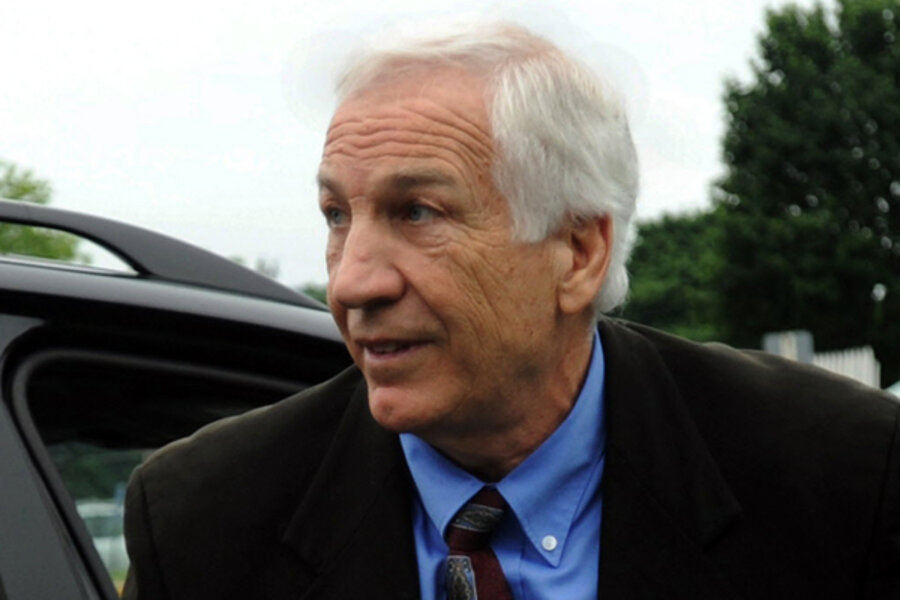Jerry Sandusky trial: To boost 'alternative story,' should he take the stand?
Loading...
| Chicago
The jury in the criminal trial of Jerry Sandusky listened last week to the emotional testimony of eight alleged victims who said the former Penn State assistant football coach sexually abused them when they were minors.
This week, the defense may put on the stand someone who is expected to provide an “alternative story” that will not dispute the context of the alleged abuse – mutual showering, for example – but who will maintain that none of the encounters led to sexual interaction: Mr. Sandusky himself. In his opening statement last week, defense lawyer Joe Amendola suggested to jurors Sandusky would take the stand.
The decision behind putting Sandusky on the stand is being weighed in legal circles as a risky move, but possibly a necessary one considering the evidence weighed against him and the high number of alleged victims involved. Most defense attorneys avoid putting their client on the stand because it focuses jurors on their credibility, creating vulnerabilities that increase with every next word out of their mouth.
“If the jury does not believe a defendant is telling the truth, they won’t pause to convict,” says Peter Henning, a law professor at Wayne State University Law School in Detroit, Mich. “What makes [the Sandusky] case different is you had very powerful testimony from eight witnesses. You can try to say maybe they’re all making it up, but once you get to eight witnesses, it’s hard to slough that off. They’re almost in need of throwing a Hail Mary because, in a sense, what else do you have to lose?”
Sandusky faces 51 criminal counts related to alleged abuse involving 10 boys over a 15-year period. All of the alleged victims met Sandusky through his children’s charity, The Second Mile.
The defense opened its case Monday with two former Penn State assistant football coaches who both described Sandusky’s behavior involving children as typical in youth athletics, where the mentoring relationship between coaches and young athletes often involves long, exhaustive days and close contact on and off the field.
Richard Anderson, a Sandusky colleague for about 20 years, testified to the strength of Sandusky’s positive reputation in the community and that “it was not uncommon” that the showering between Sandusky and his alleged victims took place “on occasion” when other coaches were in and out of the locker room. Under cross-examination, Mr. Anderson said he was not aware that Penn State prohibited boys from entering athletic department showers starting in 2001.
Another Sandusky colleague, Booker Brooks, said mutual showering in sports culture between adults and children is a “very common thing.”
The defense is also expected to rely on testimony from Dr. John O’Brien, a Philadelphia psychiatrist, who will say Sandusky suffers from histrionic personality disorder, which can create a heightened need for attention and an overly sexual or seductive appearance. Dr. O’Brien, who is known in the area for providing expert testimony in many high-profile cases over past years, conducted a two-hour evaluation of Sandusky over the weekend.
The O’Brien testimony will allow prosecutors to solicit counter testimony from other behavioral science experts, who will likely reject the connection between the diagnosis and the behavior alleged in the case.
Dr. Liza Gold, a psychiatrist at Georgetown University Medical Center in Washington, told ABC News Monday “there is no association” between the disorder “and any type of child sexual abuse of any kind.”
None of the defense’s surrogates for Sandusky are expected to deny that he had close, personal relationships with the victims. But they are expected to maintain that none of the encounters had malicious intent or led to abuse.
“The defense needs to make believable and understandable an alternative version of the events” that the jury heard last week, says Jules Epstein, a law professor at Widener University School of Law in Harrisburg, Pa. and a former criminal defense attorney. “Right now the story that is pushed and pushed and pushed is the prosecutor’s version.”
Determining whom best to tell the story may involve close family members. Dottie Sandusky is at top of the list. Last week, several of the victims said the abuse happened in the Sandusky basement when Ms. Sandusky was home upstairs. One victim said she walked into a hotel room when her husband was perpetrating the abuse in the bathroom.
Matt Sandusky, the couple’s adopted son, is also a candidate for the defense. Both he and his mother say Jerry Sandusky is innocent.
Mr. Epstein says Sandusky should only be allowed to testify if his legal team believes he can do so in “a believable and persuasive way.” His public performances to date have been disastrous: In a telephone interview with Bob Costas of NBC, Sandusky appeared aloof to the serious nature of the charges. He admitted to the showers but said they were “without intent of sexual contact.”
Despite the misstep, allowing the media access to Sandusky was likely part of the defense strategy to get in front of the story, rather than be defined by the accusations.
“I’m not going to say it was wise,” says Epstein. “You only do that when you make sure your client can handle the questioning."








